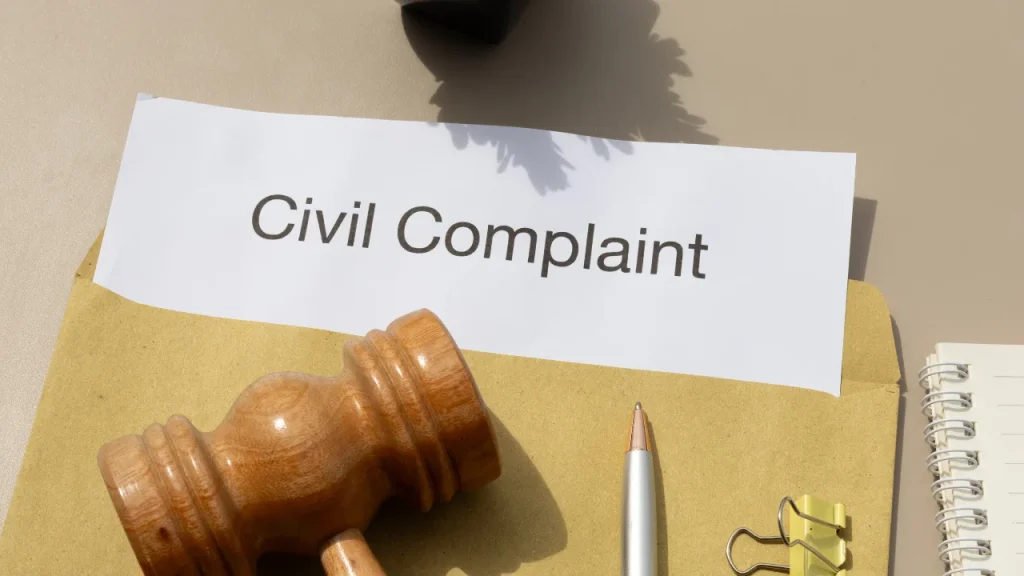How to File a Civil Lawsuit in California? Complete Filing Guide, Requirements & Court Procedures
Filing a civil lawsuit in California requires determining court jurisdiction based on claim amount, drafting a complaint on 28-line pleading paper, paying filing fees ($30-$75 for small claims, $370-$450 for superior court), serving defendants within 60 days, and meeting statute of limitations deadlines (2 years for personal injury, 4 years for written contracts, 3 years for property damage). Mandatory e-filing now applies to attorneys in most counties as of 2025.
Understanding California Court Jurisdiction: Where to File Your Lawsuit
California divides civil cases into three jurisdictions based on monetary amounts. Small claims court handles disputes up to $12,500 for individuals and $6,250 for business entities. Limited civil court processes cases involving $35,000 or less with more formal procedures than small claims. Unlimited civil court hears cases exceeding $35,000, including major business disputes, serious personal injury claims, and complex real estate litigation with strict evidentiary rules.
As of October 1, 2025, landlords can no longer sue in small claims court for unpaid COVID-19 rental debt above $12,500.
California Statute of Limitations: Critical Filing Deadlines
Most statute of limitations deadlines are defined in California Code of Civil Procedure sections 335-366.3. Missing these deadlines permanently bars your claim.
Common statute of limitations periods:
- Personal injury or wrongful death: 2 years (CCP § 335.1)
- Damage to personal property: 3 years (CCP § 338)
- Breach of a written contract: 4 years (CCP § 337)
- Breach of an oral contract: 2 years (CCP § 339)
- Fraud: 3 years from date of discovery under CCP § 338(d)
Tolling temporarily stops or extends the statute of limitations period under certain circumstances, including when the plaintiff is under 18 or legally incapacitated (CCP § 352), when defendants are out of state (CCP § 351), or during bankruptcy automatic stays.
Government entity claims require much earlier deadlines. Plaintiffs have only six months to pursue injury claims against government agencies or employees instead of the customary two-year period.

Step-by-Step: How to File a Civil Lawsuit in California
Step 1: Determine Your Cause of Action
Identify the legal basis for your lawsuit—breach of contract, personal injury, property damage, employment dispute, or other civil claim. Each cause of action has specific elements you must prove and different statute of limitations periods.
Step 2: Choose the Correct Venue and Jurisdiction
File your lawsuit where the injury happened, where the contract was supposed to happen, or where the defendant lives. Venue rules determine which California county court has proper jurisdiction.
For business defendants, check the California Secretary of State website to find the designated person for service of process for corporations, LLCs, limited partnerships, and limited liability partnerships.
Step 3: Draft Your Complaint
File either a complaint or in some situations a petition using 28-line pleading paper. Some cases have fill-in-the-blank Judicial Council forms; others require research and typing complaints on numbered pleading paper.
Your complaint must include:
- Caption with court name, case information
- Statement of jurisdiction
- Factual allegations supporting each cause of action
- Prayer for relief (damages or other remedies sought)
- Verification or declaration under penalty of perjury
- Signature and attorney information (if represented)
Step 4: Complete the Summons
The summons (Form SUM-100) notifies defendants they’re being sued and gives them 30 days to respond. Courts issue the summons when you file your complaint.
Step 5: Pay Filing Fees
The standard filing fee for civil cases in California is $405, which includes a $55 administrative fee for all civil actions except petitions for writs of habeas corpus.
Filing fee breakdown by court type:
- Small claims: $30-$75 depending on claim amount
- Limited/unlimited civil: $370-$450 initial filing
Fee waivers are available for low-income litigants who cannot afford court costs. File form FW-001 (Request to Waive Court Fees) with your complaint.
Step 6: File With the Court
Submit your complaint, summons, and filing fee to the appropriate California superior court clerk’s office. As of 2025, mandatory e-filing applies to attorneys in most California counties for civil, family law, and probate cases.
Self-represented parties are exempt from mandatory electronic filing requirements but are encouraged to participate.
The clerk will:
- Review documents for completeness
- Assign a case number
- Issue and stamp the summons
- Return endorsed copies to you
Step 7: Serve the Defendant
Service must be completed by someone over 18 who is not a party to the case, such as the Sheriff’s Civil Bureau, a registered process server, an attorney, or a friend or family member meeting these requirements.
Each defendant must be served with a stamped copy of the complaint and summons. Personal service involves personal delivery to the defendant (CCP § 415.10), while substituted service may be used if personal service fails after diligent attempts (by leaving copies at defendant’s dwelling with another person).
Within 60 days of filing the complaint, all defendants must be served and proofs of service filed showing service completion.
Step 8: File Proof of Service
After service is complete, the server must complete the Proof of Service Summons form (POS-010). File this with the court to create a record that proper service occurred.

Step 9: Wait for Defendant’s Response
Defendants have 30 days to respond from the date they were served. They can file an answer, demurrer, motion to strike, motion to transfer, motion to quash, or other responsive pleading.
If defendants don’t respond within 30 days, you can file for default judgment.
Required Documents and Pleadings
Mandatory filing documents:
- Civil complaint (on 28-line pleading paper or Judicial Council form)
- Summons (Form SUM-100)
- Civil case cover sheet (Form CM-010)
- Proof of service of summons (Form POS-010)
- Alternative dispute resolution information package
Optional documents depending on case type:
- Request for waiver of court fees (Form FW-001)
- Case questionnaire (limited civil cases only)
- Notice of case assignment and case management conference
- Request for entry of default (if defendant doesn’t respond)
California Civil Lawsuit Filing Fees and Costs 2025
Beyond the $405 standard filing fee, additional costs include attorney fees (California civil litigators charge $300-$1,000+ per hour), document certification expenses, and record retrieval fees.
Additional litigation costs:
- Service of process: $0-$75 per defendant
- Court reporter fees for depositions
- Expert witness fees
- Motion filing fees
- Appeal filing fees
- Discovery costs (document production, depositions)
Under California’s “American Rule,” each party typically pays their own legal costs regardless of who wins. Exceptions include prevailing-party clauses in contracts, statutory fee-shifting for certain consumer and civil rights cases, and sanctions for bad-faith or frivolous conduct.
Mandatory E-Filing Requirements 2025
California Rules of Court rule 2.253 allows courts to institute mandatory electronic filing and service in civil cases for represented parties. San Bernardino Superior Court implemented mandatory e-filing for all attorney-filed civil documents effective September 2, 2025. Solano County made e-filing mandatory for attorneys in civil, family, and probate cases effective January 2, 2025.
Beginning July 1, 2025, California courts are required to electronically serve court-issued notices to attorneys in civil cases, including family law matters, under amendments to Code of Civil Procedure § 1010.6 implemented through California Rule of Court 2.251.
Attorneys must register with approved Electronic Filing Service Providers (EFSPs) before filing. A party required to file electronically must be excused from requirements if they show undue hardship or significant prejudice.
Small Claims Court vs. Superior Court: Which Court Should You Choose?
Small Claims Court Benefits:
- Cases are typically faster, less complicated, and less expensive than limited civil cases
- No attorney required (businesses must be represented by employees, not lawyers)
- Informal hearing with no jury where parties represent themselves
- Lower filing fees ($30-$75)
- Simplified procedures and forms
Small Claims Court Limitations:
- Judges in small claims can generally only order one side to pay money, not other types of relief
- No discovery process
- Limited appeal rights
- Cannot use small claims for injunctions or declaratory relief
Limited/Unlimited Civil Court Benefits:
- Attorney representation allowed
- Full discovery process available
- Can request injunctions, declaratory relief, and complex remedies
- Appeal rights preserved
- Jury trial available
Limited/Unlimited Civil Court Drawbacks:
- Higher costs ($370-$450 filing fees plus attorney fees)
- Cases can take years to reach trial
- Must follow Code of Civil Procedure, California Rules of Court, and local court rules
- Complex procedural requirements
Service of Process Requirements Under California Law
Any person 18 years or over who is not a party to the action may serve the summons and complaint under California Code of Civil Procedure § 414.10. The plaintiff cannot serve the summons.
Service methods:
- Personal service: Personal delivery to the defendant (CCP § 415.10)
- Substituted service: If personal service fails after diligent attempts, serve by leaving copies at defendant’s dwelling with another person
- Service by mail: Some circumstances allow service by certified mail
- Service by publication: Court-ordered when defendant cannot be located
Service by registered process server has the advantage of being presumed valid by courts under California Evidence Code § 647.
For business entities, specific rules govern serving corporations, LLCs, partnerships, and government agencies—check California Code of Civil Procedure and the California Secretary of State about corporations and business entities.
Recent Changes to California Civil Procedure Rules 2025
E-Filing Expansion: Courts must electronically serve all notices and documents to attorneys who appear in cases, including orders, rulings, and official court communications starting July 1, 2025.
COVID-19 Rental Debt: Effective October 1, 2025, landlords can no longer sue in small claims court for unpaid COVID-19 rental debt above $12,500.
Electronic Service Requirements: Attorneys representing clients are required to accept electronic service and must ensure their email addresses are on file with the court.
Common Filing Mistakes to Avoid
Statute of limitations errors: If a case is filed past the date set by statute of limitations, the court has no leeway—the case must be dismissed. Calculate deadlines carefully considering tolling rules.
Jurisdiction and venue mistakes: Filing in the wrong court or county wastes time and money. Verify proper venue before filing.
Incomplete service of process: Improper service may result in dismissal of your case. Follow all procedural requirements exactly.
Missing the 60-day service deadline: Within 60 days of filing, all defendants must be served and proofs of service filed. Courts may dismiss cases for failure to serve timely.
Failing to file proof of service: Even proper service is meaningless without filing the proof of service form with the court.
Ignoring local court rules: Each court may have different requirements beyond the Code of Civil Procedure and California Rules of Court. Check your county’s local rules.
Improper pleading format: Complaints must be on 28-line pleading paper unless Judicial Council forms are available. Courts reject improperly formatted documents.
What Happens After You File Your Civil Lawsuit
Case Management: Courts assign case numbers and may schedule case management conferences to set discovery schedules, motion deadlines, and trial dates.
Discovery Phase: The discovery phase involves gathering evidence, taking depositions, and exchanging documents—often the most expensive part of civil litigation. Discovery includes interrogatories, requests for production, requests for admission, and depositions.
Motion Practice: Parties file motions for various reasons including motions to dismiss, motions for summary judgment, discovery motions, and motions in limine.
Settlement Negotiations: Many California courts require settlement conferences before trial, and alternative dispute resolution (ADR) methods like mediation and arbitration are confidential, flexible, and cheaper than trial.
Trial: If settlement fails, cases proceed to trial. Unlimited civil cases follow strict rules of civil procedure and evidence and can take years to reach trial.
Judgment and Enforcement: After trial, the court enters judgment. Prevailing parties must often take additional steps to collect judgments.
Do You Need an Attorney to File a Civil Lawsuit in California?
If you’re representing yourself, you will be held to the same standard as a lawyer—to know and follow the Code of Civil Procedure and Rules of Court.
When attorneys are recommended:
- Unlimited civil cases exceeding $35,000
- Complex legal issues
- Business entity plaintiffs (required in some cases)
- Cases requiring extensive discovery
- Medical malpractice or professional liability claims
Self-representation options:
- Small claims court where parties represent themselves without lawyers
- Every California superior court has a self-help civil center providing free legal information to people without lawyers
- Limited scope representation (unbundled legal services)
California Government Tort Claims Process
If you are suing a government entity, you MUST exhaust administrative remedies prior to filing a lawsuit. Instead of the customary two-year statute of limitations, plaintiffs have only six months to pursue injury claims against government agencies or employees.
File a claim with the appropriate government agency first using the California Tort Claims Act procedures. Only after claim denial or deemed denial can you file a lawsuit in court.
California Civil Litigation Timeline: How Long Does It Take?
Small claims cases: 30-90 days from filing to hearing
Limited civil cases: 6-18 months depending on complexity and court backlog
Unlimited civil cases: Cases can take years to get to trial, especially those involving lengthy discovery processes. Complex cases may take 2-5 years or longer.
Factors affecting timeline:
- Court calendar congestion
- Discovery disputes
- Motion practice
- Number of parties involved
- Settlement negotiations
- Continuances and delays
Frequently Asked Questions
What are the steps to file a civil lawsuit in California?
Determine jurisdiction and venue, draft a complaint on 28-line pleading paper, pay filing fees ($30-$75 for small claims, $370-$450 for superior court), file with the court clerk, serve defendants within 60 days, and file proof of service. Meet statute of limitations deadlines: 2 years for personal injury, 4 years for written contracts.
What documents do I need to file a civil lawsuit?
Required documents include a civil complaint (on 28-line pleading paper or Judicial Council form), summons (Form SUM-100), civil case cover sheet (Form CM-010), and proof of service (Form POS-010). Optional documents include fee waiver requests and case questionnaires.
What is the filing fee for a civil lawsuit in California?
Standard civil filing fees are $405 (including $55 administrative fee) for superior court cases. Small claims filing fees range from $30-$75 depending on claim amount. Fee waivers are available for low-income litigants.
What is the statute of limitations for civil cases in California?
Common limitations periods: 2 years for personal injury, 4 years for written contract breaches, 2 years for oral contract breaches, 3 years for property damage, 3 years for fraud (from discovery date). Government entity claims require filing within six months.
Do I need an attorney to file a civil lawsuit in California?
Attorneys are not legally required but are recommended for unlimited civil cases, complex legal issues, and cases exceeding $35,000. Self-represented litigants are held to the same legal standards as attorneys. Small claims court is designed for self-representation.
What is the difference between small claims and superior court?
Small claims handles cases up to $12,500 ($6,250 for businesses), has informal procedures, no attorneys, lower costs, and faster resolution. Superior court handles larger amounts with formal procedures, full discovery, attorney representation, and longer timelines.
How long does the civil lawsuit process take in California?
Small claims cases take 30-90 days. Limited civil cases take 6-18 months. Unlimited civil cases can take 2-5 years or longer depending on complexity, discovery needs, and court calendar congestion.
Disclaimer: This article provides factual information about how to file a civil lawsuit in California based on current California court procedures, California Rules of Court, and verified legal resources. It is for educational purposes only and does not constitute legal advice. Procedures, filing fees, and statute of limitations are subject to change. For specific legal advice regarding your civil lawsuit, please consult with a qualified California civil litigation attorney. Always verify current filing requirements with your local California Superior Court before filing.
Related Articles
- Can You Sue a Bank for Identity Theft? Legal Standards, Consumer Protection Laws & Recent Rulings
- Can You Sue for Identity Theft? Legal Claims, Damages & Your Rights Explained
- Property Owner Subject to Legal Claim: Legal Exposure and Protections
Meta Description: Learn how to file a civil lawsuit in California with our complete 2025 guide. Step-by-step filing procedures, required documents, filing fees, statute of limitations, e-filing requirements & court jurisdiction rules explained.
Additional Resources
Official California Court Resources:
- California Courts Self-Help Center
- California Rules of Court
- California Code of Civil Procedure
- Superior Court Civil Division (by county)
E-Filing Service Providers: Check with your local superior court for approved EFSP providers in your county.
Legal Aid Organizations: California has numerous legal aid organizations providing free or low-cost assistance to eligible individuals. Contact your county bar association for referrals.
About the Author

Sarah Klein, JD, is a former civil litigation attorney with over a decade of experience in contract disputes, small claims, and neighbor conflicts. At All About Lawyer, she writes clear, practical guides to help people understand their civil legal rights and confidently handle everyday legal issues.
Read more about Sarah
